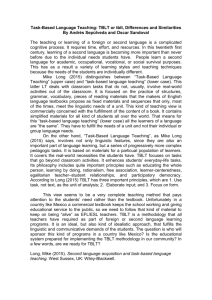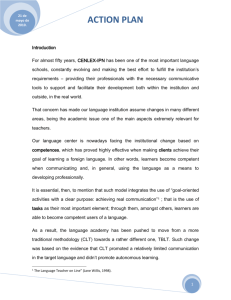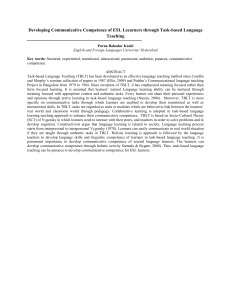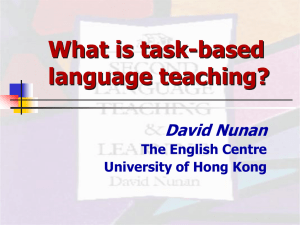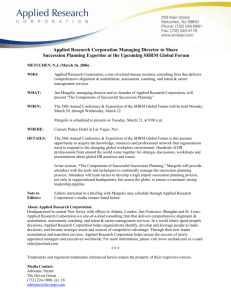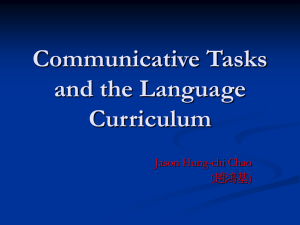Korean EFL Learner Tactics for Effective Interaction and Production
advertisement
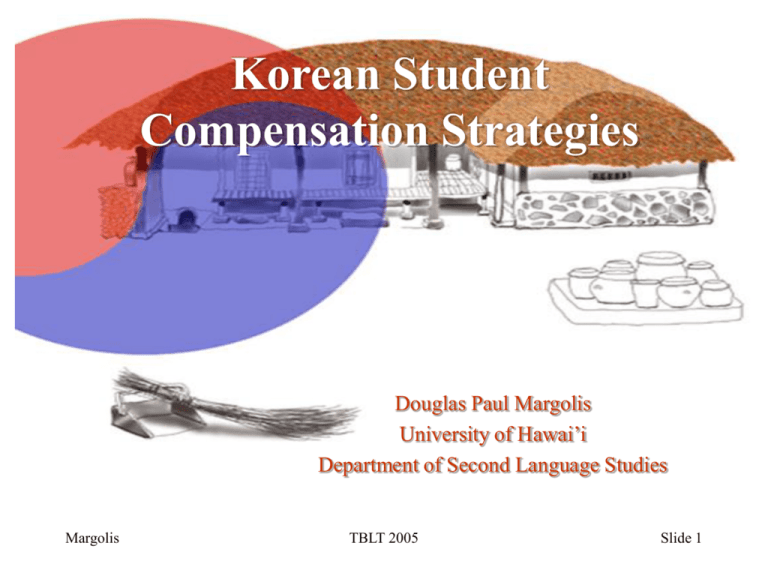
Korean Student Compensation Strategies Douglas Paul Margolis University of Hawai’i Department of Second Language Studies Margolis TBLT 2005 Slide 1 Ugh! Warm up Teacher: “Nick, what is the past participle of the verb to ring?” Nick: “What do you think it is, Sir?” Teacher: “I don’t think. I KNOW!” Nick: Margolis “I don’t think I know either, Sir!” TBLT 2005 Slide 2 TBLT & CS Skehan, 1998 • Immersion studies • Privilege of fluency over accuracy • Compensation Strategies should be avoided in TBLT Margolis TBLT 2005 Slide 3 Korean Student Characteristics • Rote memorization study • Grammar Translation / synthetic syllabus • Study for tests, not communication • Difficulty moving from accuracy to fluency • Error avoidance tendencies • Little experience with TBLT Margolis TBLT 2005 Slide 4 Compensation Strategies Definition Compensation strategies (Oxford, 1990) active, conscious techniques students can adopt and teachers can teach, to compensate for gaps in linguistic and lexical knowledge in the target language. Margolis TBLT 2005 Slide 5 Research Design Research Questions 1. 1. 2. 3. 4. 2. Survey (Based on Oxford’s SILL) To which compensation strategies do Korean EFL 37 comp. strats / 5 self assess ability items (see handout) university students most/least resort? 10 Universities (100 Ss each) Identify most/least used by comparing means Does student English proficiency level affect compensation strategy utilization? Margolis TBLT 2005 Slide 6 Study Participants Korean EFL university students Age range: 17-63 (majority 21-24) Gender: Female 60% Male 40% School Locations: Seoul 42% Urban (not Seoul) 28% Rural 30% Margolis TBLT 2005 Slide 7 Results: Most Utilized Strategies Strategy Mean SD 1st Guess meaning from context 3.77 .83 2nd Find clues to meaning in other parts 3.63 .85 3rd Replace unknown word with synonym or similar word 3.52 .88 4th Guess meaning from gestures or expressions 3.49 .93 5th Avoid difficult grammar 3.46 1.03 6th Circumlocute 3.44 .93 Margolis TBLT 2005 Slide 8 Results: Least Utilized Strategies Strategy Mean SD 1st Brainstorm words in a topic before writing 2.10 .87 2nd Use approximations like /p/ for /f/ 2.25 1.10 3rd Write heard words to help guess meaning 2.35 1.04 4th Coin words when you can’t remember one 2.55 1.08 5th Ask speaker to repeat w/ diff words or expression 2.60 .98 6th Use an antonym to ask for an unknown word 2.64 1.00 Margolis TBLT 2005 Slide 9 Factor Analysis Eigenvalue Three types of strategies hypothesized: 1) Rising (Increase use as ability increases) 2) Falling (Decrease use as ability increases) 3) Horizontal (Relatively no change related to ability) Principal component analysis Varimax rotation, 3 components Cumulative 31.90% of the variance. Saved as regression factor scores Scree Plot 8 6 4 2 0 1 5 3 9 7 13 11 17 15 21 19 25 23 29 27 33 31 Component Number Margolis TBLT 2005 Slide 10 37 35 Factor Analysis -2Component 1 Component 2 Component 3 (Rising, negotiation) (Rising, achievement, guessing) (Falling, reduction, breakdown) 32, 21, 14, 13, 31, 33, 19, 11, 23, 12, 26, 18, 20 8, 9, 6, 16, 28, 15, 34, 10, 24 38, 37, 40, 29, 28, 25, 30, 27 Interaction oriented Interlocutor assistance Reception oriented Speaking oriented Margolis TBLT 2005 Slide 11 Results • Three types of strategies seem distinguished. • Comparisons of factor scores by ability levels reveals the rising and falling patterns. • There is a significant difference in strategy use at differing ability levels. • Korean EFL learners in this study most used a guessing from context strategy and least used brainstorming strategies in writing. Margolis TBLT 2005 Slide 12 Limitations • Self reports (not clear evidence of behavior) • Causal connection remains unclear • The difference in range between most used and least used strategy mean = 1.67 • Restricted range of the 5 pt. Likert Scale Margolis TBLT 2005 Slide 13 Implications for TBLT 1. Teach students rising strategies 2. Encourage students to avoid falling strategies 3. In Korea, TBLT may require compensation strategy training to help students overcome fears of error. 4. Clarification requests and confirmation checks may be more appropriate feedback types in Korean TBLT context. 5. As student communication ability increases, the types of strategies they use appear to change whether or not strategy training is implemented. Margolis TBLT 2005 Slide 14 Douglas Margolis Margolis Department of Second Language Studies University of Hawai’i margolis@hawaii.edu 1-808-956-2792 TBLT 2005 Slide 15
